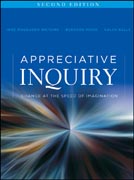
Appreciative inquiry: change at the speed of imagination
Watkins, Jane Magruder
Mohr, Bernard J.
INDICE: Chart of Case Stories. 1. THE CASE FOR A NEW APPROACH TO CHANGE. The Emerging Paradigm. The New Sciences. Thinking About Problems Using the New Paradigm. 2. APPRECIATIVE INQUIRY: HISTORY, THEORY, AND RESEARCH. Defining Appreciative Inquiry. A History of Appreciative Inquiry. AI and the Field of Organization Development. The Relevance of Appreciative Inquiry to Complex, Transformational Change. AI and the Challenge of Organization Transformation. ComplexChange and the Two Gifts of Appreciative Inquiry. The Theoretical Basis for Appreciative Inquiry. Social Constructionism. The Power of Image. Social Constructionism + The Power of Image = Appreciative Inquiry in Organization Change. What Good Are Positive Emotions? Case Story: Living Well with Dementia: Creating a Regional Strategy for the East Midlands (Julie Barnes and Jill Guild). 3.APPRECIATIVE INQUIRY AS A PERSPECTIVE FOR ORGANIZATION CHANGE. The DNA of Appreciative Inquiry. The Core Principles of AI. Are Principles Important? The Five Original Principles Plus Wholeness. The Five Generic Core Processes for Guiding AI-Based Change. Multiple Models of the Five Generic Core Processes of AI. The Original Cooperrider/Srivastva Model. The GEM Initiative Four D Model. AFifth D. The Mohr/Jacobsgaard Four I Model. Skills and Knowledge Needed to Lead AI Processes. Case Story: Using the SOAR Framework at Aerospace Alliant International (AAI) (Jacqueline M. Stavros). Case Story: The Results of Appreciative Management by a Corporate Manager (Daniel Saint). 4. CHOOSE THE POSITIVE AS THE FOCUS OF INQUIRY (DEFINE). Define: Focusing on the Positive. Raising theChoice Point. Explaining and Demonstrating. Identifying the Focus for AI. Case Story: AI Stories from a Training and Technical Assistance Center (T/TAC): New Possibilities for Improving Outcomes for Students with Disabilities (DenyseDoerries, Donni Davis-Perry, and Lori Korinek). Case Story: From Deficits to Strengths: Six Sigma from the AI Perspective (David Shaked). 5. INQUIRE INTO STORIES OF WHAT GIVES LIFE TO THE SYSTEM (DISCOVER). Rationale for the Use of Stories. A Preparation Workshop to Develop the Customized Interview Protocol and Decide on an Inquiry Process. Step 1: Select a Core Group and Possibly a Steering Team. Step 2: Orient Participants to the Goals of the Workshop and to Their Role in Meeting the Goals. Step 3: Quickly Get Participants into an Experience of AI. Step 4: Debrief the Mini-AI Experience. Step 5: Share Highlights of the Interviews and Select Topics for Further Inquiry. Step 6: Create Questions to Be Added to the Four Generic Questions. Step 7: Develop the Inquiry Process. Interviewer Training. Conclusion. Case Story: Appreciative Living: Using AI in Daily Life (Jacqueline Kelm). Case Story: Appreciative Life Coaching (Bob Tschannen-Moran). 6. LOCATE THEMES THAT APPEAR IN THE STORIES (DISCOVER). Identifying Themes.
- ISBN: 978-0-470-52797-9
- Editorial: John Wiley & Sons
- Encuadernacion: Rústica
- Páginas: 336
- Fecha Publicación: 06/04/2011
- Nº Volúmenes: 1
- Idioma: Inglés
